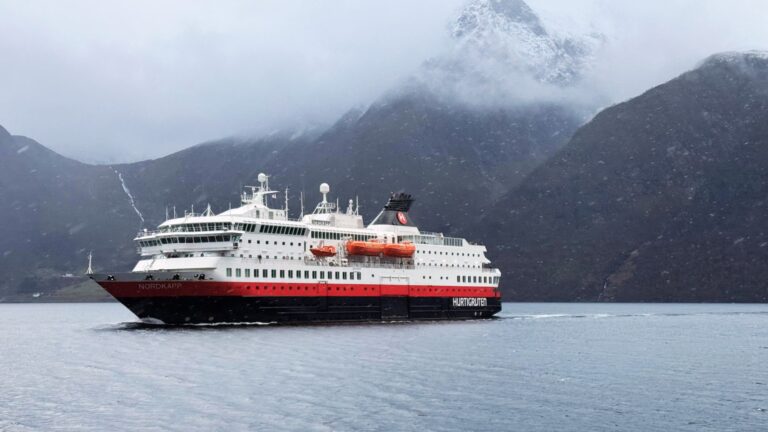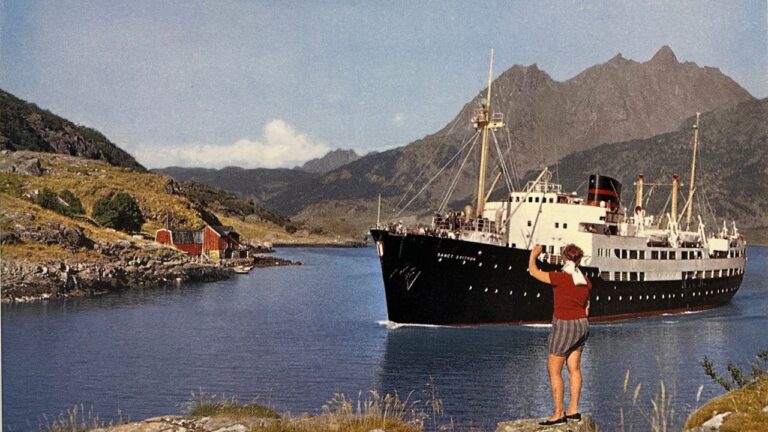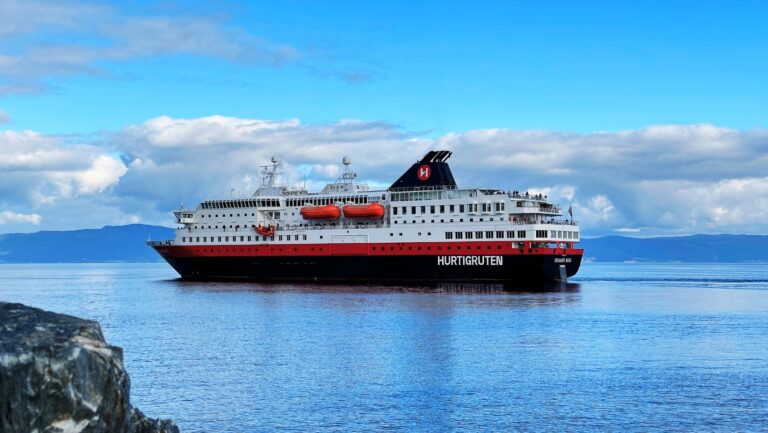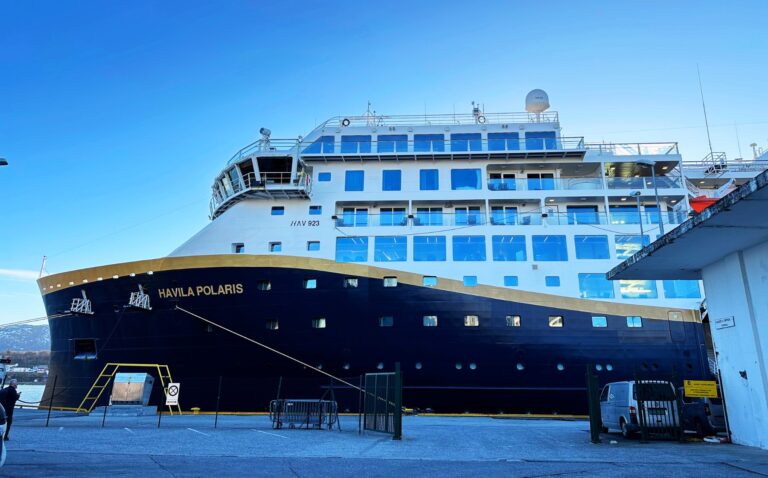For over 130 years, Norway's coastal ferry route has connected small communities along one of the world's most dramatic coastlines. Here's the full story of the route, which is today served by Hurtigruten and Havila.
This historic service isn’t just a lifeline for Norwegians—it’s a journey that has captured the imagination of travellers worldwide, evolving into a unique blend of local transport and iconic travel experience.

Unlike other ferry routes, the Norwegian coastal voyage stands out for its dual purpose: local ferry for passengers and cargo, and tourism.
It supports remote communities by carrying passengers and cargo while also welcoming international tourists seeking a front-row seat to Norway’s natural wonders.
Whether it’s the midnight sun of summer or the northern lights of winter, this route offers a window into Norway’s landscapes, culture, and history.
⚓ Find Out More: Discover more about Hurtigruten's Coastal Voyages
🇳🇴 Bor du i Norge? Oppdag Hurtigrutens tilbud på kystreisen her!
Today, two companies, Hurtigruten and Havila, operate daily departures on the route, offering travelers a choice between traditional charm and modern innovation.
But behind the scenic views and comfortable cabins lies a fascinating history of how this service transformed Norwegian coastal life.
The Origins of Norway’s Coastal Express
Before 1893, transporting mail, goods, and people to northern Norway was slow and unreliable, with most journeys relying on small boats navigating treacherous waters. Roads were scarce, and winters made travel even more challenging.
Recognising the need for better connectivity, the Norwegian government commissioned a regular coastal service.
Captain Richard With and his company ‘Vesteraalens Dampskibsselskab' pioneered the route with their vessel Vesteraalen, making the first scheduled journey from Trondheim to Hammerfest in July 1893.

The trip, which included stops in key towns such as Bodø, Tromsø, and Svolvær, took 67 hours—an impressive improvement at the time. The early success of the route spurred interest from other shipping companies, and more vessels joined the service.
By the early 20th century, the route had expanded, gradually connecting more towns and offering year-round operations in northern Norway.
Over time, “Hurtigruten” became the widely recognised name for the coastal route service regardless of the operator. In English, “Hurtigruten” means “The Quick Route”.
The term referred to the significant improvement in speed and reliability compared to the unpredictable and lengthy transport methods previously used.
Expansion and Innovation
The coastal route quickly became a cornerstone of Norway’s transport network. As additional shipping companies joined the service, the fleet expanded, and the timetable improved.
By the 1930s, the route offered daily services during the summer months, connecting more communities and facilitating regional trade and communication.
Initially, routes varied by season, with limited service during the harsh winter months. However, improvements in ship design and navigation technology enabled year-round service to remote locations, even during Arctic winters.
This reliability solidified the route’s reputation as a lifeline for Norway’s isolated coastal towns.
The Coastal Express During Wartime
World War II marked a challenging period for the coastal ferry service. Norway’s strategic coastline made it a target during the German occupation, and many ships were sunk or damaged during the war.
Despite the risks, the service continued, playing a vital role in transporting essential supplies and personnel. After the war, the government prioritised rebuilding the fleet and restoring the coastal service.
By the 1950s, the route resumed full operations, with a consistent daily connection between Bergen and Kirkenes. This post-war revival underscored the importance of the service to Norway’s recovery and development.
The Rise of Passenger Comfort
By the 1950s and 1960s, advancements in shipbuilding allowed for larger and faster vessels, enabling operators to significantly enhance the passenger experience.

These innovations went beyond functionality, introducing new levels of comfort for those traveling along Norway’s rugged coastline.
While the route still served as a practical ferry service, ships began offering more modern cabins, better dining options, and panoramic lounges designed for sightseeing.
These features not only improved the experience for local passengers but also began to attract the attention of international travellers looking to explore Norway’s unique landscapes.
The gradual addition of amenities marked a turning point in the route’s evolution. It was no longer just a means of transport but a more enjoyable and memorable journey.
By the 1980s, newer vessels were purpose-built with tourism in mind, setting the stage for the route’s growing reputation as a scenic travel experience.
The Route’s Evolution from Lifeline to Leisure
For much of the 20th century, the coastal ferry route was an essential lifeline for remote communities in northern Norway. It carried cargo, mail, and passengers in an era when roads were scarce, and air travel was still in its infancy.
However, the development of modern infrastructure during the 1960s and 1970s, including regional airports and better road connections, began to challenge the route’s dominance as a transport network.
To remain economically viable, operators gradually shifted their focus from local transport to tourism. Scenic landscapes, cultural access, and seasonal phenomena like the midnight sun and northern lights became the primary attractions.
By the 1980s, this strategic pivot transformed the route into a bucket-list experience for international travelers, particularly those from Germany, the UK, and the US.
Guided excursions, onboard lectures, and expanded public spaces were introduced, creating a hybrid model that maintained the route’s lifeline function while embracing its new role as a tourism powerhouse.
The Creation of “Hurtigruten”
The current Hurtigruten company was established in 2006 through the merger of two long-standing operators on the coastal route: Ofotens og Vesteraalens Dampskibsselskab (OVDS) and Troms Fylkes Dampskibsselskap (TFDS).
Both companies had operated on the route for decades, and the merger aimed to streamline operations, modernise the fleet, and strengthen the brand in the face of increasing competition from other travel options.
The new entity adopted the name “Hurtigruten,” which had long been synonymous with the coastal voyage.
This marked a significant step in the route's evolution, as the company increasingly shifted its focus toward tourism, while continuing to fulfil its role as a vital transport link for Norway’s coastal communities.
The Modern Coastal Route
Today, the coastal voyage spans 11 days, covering 34 ports between Bergen and Kirkenes.

Both Hurtigruten and Havila now operate on the route, following a 2021 government decision to reintroduce competition on the route. Hurtigruten runs seven of the 11 departures, while Havila operates the remaining four.
Each company puts a distinct experience on the journey, but the fundamentals remain the same. Comfortable cabins and excellent food for voyage passengers, with a focus on the essential services for local passengers and cargo.
Havila’s modern fleet has certainly pointed towards the future of the route, and ferry transport in general.
Each of the four ships incorporates cutting-edge technology, including LNG engines and large battery packs that allow for emissions-free sailing in sensitive areas. Read about my experience of 11 nights aboard the Havila Polaris.
A Sustainable Future for the Coastal Route
Looking ahead, sustainability is shaping the future of Norway’s coastal route.
Both operators are investing in green technology to comply with strict environmental regulations, including upcoming laws requiring zero-emission vessels in the UNESCO-listed fjords from 2032, delayed from the original date of 2026.
⚓ Find Out More: Discover more about Hurtigruten's Coastal Voyages
🇳🇴 Bor du i Norge? Oppdag Hurtigrutens tilbud på kystreisen her!
Havila’s new fleet is already setting benchmarks with hybrid capabilities, while Hurtigruten is retrofitting its older ships and collaborating on research for zero-emission designs.
As the route approaches its next chapter, it remains a symbol of Norway’s innovation and resilience.
Whether you’re a local using the ferry as a lifeline or an international visitor eager to explore the Arctic under the northern lights, this historic route offers an unparalleled connection to Norway’s past, present, and future.

